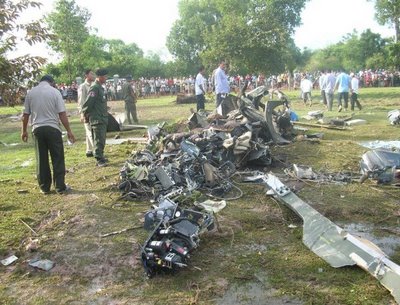
Andhra Pradesh Chief Minister Y.S. Rajasekhara Reddy’s death in a chopper crash has added to the growing list of Indian politicians killed in aerial accidents. In a country where helicopters are frequently used to ferry VIPs, some also had a narrow escape.
Aviation experts say the helicopter crash rate is much higher compared to that of commercial planes the world over, and this is true of India as well.
YSR’s chopper crashed in a forest while flying in a Bell 430 to Chitoor district. He was confirmed dead Thursday, 27 hours after the helicopter went missing.
The tragedy is a grim reminder of the deaths in aerial crashes of Indian politicians Sanjay Gandhi, Madhavrao Scindia, G.M.C. Balayogi, S. Mohan Kumaramangalam, O.P. Jindal, Surendra Singh, Dera Natung and C. Sangma.
Perhaps one of the first Indian political leaders to die in a plane crash was freedom fighter Subhas Chandra Bose — on Aug 18, 1945 in present day Taiwan. But many insist to this day that he survived.
Sanjay Gandhi, the younger son of then prime minister Indira Gandhi, was killed when a glider he was flying crashed soon after taking off from the Safdarjung airport in Delhi in 1980.
Scindia, a senior Congress leader and a former cabinet minister, was killed in a plane crash Sep 30, 2001 while traveling to Kanpur in Uttar Pradesh to address a public rally.
Lok Sabha speaker and Telugu Desam Party (TDP) leader G.M.C. Balayogi died in a chopper crash March 3, 2002 in Andhra Pradesh. Balayogi was in a Bell 206 helicopter.
An official probe ruled that the crash was caused when the pilot, unable to continue due to poor visibility, mistakenly landed on a pond thinking it was a land surface.
Kumaramangalam, from the Congress, died in a plane crash in 1973 near New Delhi.
Haryana’s then power minister O.P. Jindal, a noted industrialist, and agriculture minister Surendra Singh were killed when the chopper carrying them developed a technical snag and went down near Saharanpur in Uttar Pradesh March 31, 2005.
Arunachal Pradesh education minister Natung was killed in a helicopter crash in May 2001.
Sangma, the then Meghalaya community development minister, three legislators and six others were killed in a helicopter crash in September 2004.
Punjab governor Surendra Nath and nine members of his family were killed when the government’s Super-King aircraft crashed into high mountains in bad weather July 9, 1994 in Himachal Pradesh. Nath was then acting Himachal governor also.
It’s as incredible as it can get and proves that helicopter crashes need to be taken more seriously. The Bell 430 crash which killed YSR as we see was not the first of its kind. In 2007 and then in 2008, the country saw eerily similar helicopter crashes. Each detail was the same and so was the sequence of events. The only difference between these three crashes was that in the third crash a VVIP died and so the country finally woke up to the dangers of flying in bad weather without proper safety equipments on board.
“If one had learnt lessons from the earlier two monsoon crashes the third such accident could have been avoided by installing what is called an enhanced ground proximity warning system (EGPWS),” said a senior helicopter pilot. Simply put, an EGPWS warns a pilot for many dangers, including that of terrain ahead, such as a hill. “If the Andhra government had installed the EGPWS, which costs about Rs 75 lakh, the Bell 430 pilot would have got a warning when the chopper was nearing the hill and he would have pulled up the aircraft in time,” says the pilot. Initial investigation reports into the crash suggest that the chopper that last reported flying at 5,500 feet descended to a lower flight level to possibly avoid fast-developing cumulonimbus (Cb) clouds in the area and to keep the ground in sight. It then crashed into the Rudrakunduru hillock, which was about 3,200 feet high and stood straight ahead of the chopper’s flight path.
Nothing was different in the earlier accidents. Last year, on August 3 a Bell 430, hired by the Chattisgarh government took off from Hyderabad’s Begumpet airport for Raipur in heavy rains, with thick Cb clouds en route. The chopper lost contact an hour later. Rumours did rounds that Maoists must have gunned it down in Bastar. Since the occupants were not VIPs-only two pilots and two others-the nation did not come together for a search operation. The wreckage was found three months later on top of Kodijuttugutta hillock in Khammam.
Investigations revealed that the pilot did exactly what YSR’s pilot had done. He diverted from his flight path, flew low to duck the thick clouds only to fly into a hill which remained hidden due to poor visibility. In aviation parlance, it is called a Controlled Flight Into Terrain (CFIT).
A year before that, the first such CFIT accident involving a chopper took place on July 14, 2007. This time around, Chhattisgarh government owned EC-135 helicopter took off from Bhopal for Raipur and disappeared after an hour. Again it was raining heavily, flight path was thick with Cb clouds and rumours that Maoists must have shot it down did rounds. A week later the wreckage was found on top of a hillock near Dammudhara. The helicopter pilot committed the same mistake. He tried to avoid the thick clouds, diverted from his flight path, flew low, crashed into a hill. Three years, three similar crashes. One can only hope this was the last instance.



